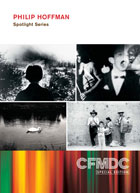
Philip Hoffman: Spotlight Series 2007
Distributed by Canadian Filmmakers Distribution Centre, 401 Richmond St. W., Suite 119, Toronto, Ontario, Canada M5V 3A8; 416-588-0725
Producer n/a
Directed by Philip Hoffman
DVD, color, 72 min.
College - Adult
Film Studies, Media Studies, Fine Arts
Date Entered: 09/30/2009
Reviewed by Oksana Dykyj, Head, Visual Media Resources, Concordia University, MontrealCFMDC’s Spotlight Series highlights the work of several experimental filmmakers. The three films found on this particular compilation DVD are from the early part of Philip Hoffman’s career and have, over the years, made their way into the canon of the study of experimental film. Somewhere Between Jalostotitlan & Encarnation (1984, 6 minutes), ?O, Zoo! (The Making of a Fiction Film) (1986, 23 minutes), and passing through / torn formations (1988, 43 minutes) are regularly found on university screening lists and syllabi . This compilation is a result of CFMDC’s clear understanding of what academia requires and yet their selection is also highly accessible to anyone interested in exploring experimental film relating to the notion of film as a medium of representation. Inspired by Haiku poetry, Somewhere Between Jalostotitlan & Encarnation begins with this verse: “Looking through the lens/ I recall what once was/ and consider what might be.” Hoffman, whose last two films were made in digital video and HD worked in 16mm film until 2001, returning with digital works after 2007. Information about his work, his involvement in teaching and articles are available on his website. In addition CFMDC has valuable resources on their own website.
Of the three films on the compilation, ?O, Zoo is probably the film which may generate the most discussion in terms of common experience. Having been left old family films, Hoffman conjures up an imaginative way to incorporate documents of the past with a documentary set in the present. On the one hand we have a filmic archeology of inherited footage, and on the other, it is inserted into a reflexive documentary about shooting a documentary of a film being made. The relationships between the time periods and the nature of the footage adds an interesting dimension to the narrative structure. The seriousness of the experimental form as in the case of a film diary and autobiographical meditation is shown in Hoffman’s passing through / torn formations. Family secrets are divulged in a fragmentary fashion akin to the understanding the narrative unfolding of one’s family history.
These three films offer the viewer a perspective on how an artist can create wholly personal works within an increasingly impersonal medium. Highly recommended.